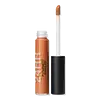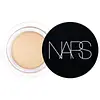Mac Cosmetics Studio Fix 24-Hour Smooth Wear Concealer Versus NARS Cosmetics Soft Matte Complete Concealer
What's inside
What's inside
 Key Ingredients
Key Ingredients

 Benefits
Benefits

 Concerns
Concerns

 Ingredients Side-by-side
Ingredients Side-by-side

Cyclopentasiloxane
EmollientWater
Skin ConditioningTrimethylsiloxysilicate
EmollientButylene Glycol
HumectantPEG/PPG-18/18 Dimethicone
EmulsifyingSorbitan Sesquioleate
EmulsifyingTribehenin
EmollientMagnesium Sulfate
Phenyl Trimethicone
Skin ConditioningDimethicone Crosspolymer
Emulsion StabilisingDimethicone
EmollientMethicone
EmollientSilica
AbrasiveNylon-12
Olea Europaea Leaf Extract
PerfumingAlgae Extract
EmollientOryza Sativa Bran Extract
Skin ConditioningGlycerin
HumectantEthylhexylglycerin
Skin ConditioningLaureth-7
EmulsifyingXanthan Gum
EmulsifyingTocopheryl Acetate
AntioxidantSodium Hyaluronate
HumectantTocopherol
AntioxidantCaprylyl Glycol
EmollientPentaerythrityl Tetra-Di-T-Butyl Hydroxyhydrocinnamate
AntioxidantPhenoxyethanol
PreservativeChlorphenesin
AntimicrobialSorbic Acid
PreservativeCI 77891
Cosmetic ColorantCI 77492
Cosmetic ColorantCI 77491
Cosmetic ColorantCI 77499
Cosmetic ColorantCyclopentasiloxane, Water, Trimethylsiloxysilicate, Butylene Glycol, PEG/PPG-18/18 Dimethicone, Sorbitan Sesquioleate, Tribehenin, Magnesium Sulfate, Phenyl Trimethicone, Dimethicone Crosspolymer, Dimethicone, Methicone, Silica, Nylon-12, Olea Europaea Leaf Extract, Algae Extract, Oryza Sativa Bran Extract, Glycerin, Ethylhexylglycerin, Laureth-7, Xanthan Gum, Tocopheryl Acetate, Sodium Hyaluronate, Tocopherol, Caprylyl Glycol, Pentaerythrityl Tetra-Di-T-Butyl Hydroxyhydrocinnamate, Phenoxyethanol, Chlorphenesin, Sorbic Acid, CI 77891, CI 77492, CI 77491, CI 77499
Dimethicone
EmollientWater
Skin ConditioningGlycerin
HumectantNylon-12
Butylene Glycol
HumectantParaffin
PerfumingDimethicone/Vinyl Dimethicone Crosspolymer
Skin ConditioningDicaprylyl Carbonate
EmollientPEG-10 Dimethicone
Skin ConditioningSorbitan Sesquiisostearate
EmulsifyingPEG-400
Emulsion StabilisingSilica
AbrasiveAluminum Hydroxide
EmollientPolysilicone-2
Microcrystalline Wax
Emulsion StabilisingCI 77120
Cosmetic ColorantDistearyldimonium Chloride
Palmitic Acid
EmollientHydrogen Dimethicone
Palmitoyl Tripeptide-5
Skin ConditioningTocopheryl Acetate
AntioxidantAscorbic Acid
AntioxidantRetinyl Palmitate
Skin ConditioningAlumina
AbrasiveSodium Acetylated Hyaluronate
HumectantTocopherol
AntioxidantPhenoxyethanol
PreservativeCI 77163
Cosmetic ColorantIron Oxides
Mica
Cosmetic ColorantCI 77891
Cosmetic ColorantDimethicone, Water, Glycerin, Nylon-12, Butylene Glycol, Paraffin, Dimethicone/Vinyl Dimethicone Crosspolymer, Dicaprylyl Carbonate, PEG-10 Dimethicone, Sorbitan Sesquiisostearate, PEG-400, Silica, Aluminum Hydroxide, Polysilicone-2, Microcrystalline Wax, CI 77120, Distearyldimonium Chloride, Palmitic Acid, Hydrogen Dimethicone, Palmitoyl Tripeptide-5, Tocopheryl Acetate, Ascorbic Acid, Retinyl Palmitate, Alumina, Sodium Acetylated Hyaluronate, Tocopherol, Phenoxyethanol, CI 77163, Iron Oxides, Mica, CI 77891
 Reviews
Reviews

Ingredients Explained
These ingredients are found in both products.
Ingredients higher up in an ingredient list are typically present in a larger amount.
Butylene Glycol (or BG) is used within cosmetic products for a few different reasons:
Overall, Butylene Glycol is a safe and well-rounded ingredient that works well with other ingredients.
Though this ingredient works well with most skin types, some people with sensitive skin may experience a reaction such as allergic rashes, closed comedones, or itchiness.
Learn more about Butylene GlycolCi 77891 is a white pigment from Titanium dioxide. It is naturally found in minerals such as rutile and ilmenite.
It's main function is to add a white color to cosmetics. It can also be mixed with other colors to create different shades.
Ci 77891 is commonly found in sunscreens due to its ability to block UV rays.
Learn more about CI 77891Dimethicone is a type of synthetic silicone created from natural materials such as quartz.
What it does:
Dimethicone comes in different viscosities:
Depending on the viscosity, dimethicone has different properties.
Ingredients lists don't always show which type is used, so we recommend reaching out to the brand if you have questions about the viscosity.
This ingredient is unlikely to cause irritation because it does not get absorbed into skin. However, people with silicone allergies should be careful about using this ingredient.
Note: Dimethicone may contribute to pilling. This is because it is not oil or water soluble, so pilling may occur when layered with products. When mixed with heavy oils in a formula, the outcome is also quite greasy.
Learn more about DimethiconeGlycerin is already naturally found in your skin. It helps moisturize and protect your skin.
A study from 2016 found glycerin to be more effective as a humectant than AHAs and hyaluronic acid.
As a humectant, it helps the skin stay hydrated by pulling moisture to your skin. The low molecular weight of glycerin allows it to pull moisture into the deeper layers of your skin.
Hydrated skin improves your skin barrier; Your skin barrier helps protect against irritants and bacteria.
Glycerin has also been found to have antimicrobial and antiviral properties. Due to these properties, glycerin is often used in wound and burn treatments.
In cosmetics, glycerin is usually derived from plants such as soybean or palm. However, it can also be sourced from animals, such as tallow or animal fat.
This ingredient is organic, colorless, odorless, and non-toxic.
Glycerin is the name for this ingredient in American English. British English uses Glycerol/Glycerine.
Learn more about GlycerinNylon-12 is a polymer. It is derived from 12-aminododecanoic acid, an omega-amino fatty acid
According to a manufacturer, it is a talc substitute. Like talc, nylon-12 gives products a satin feel. The manufacturer also claims this ingredients does not block pores and has moderate oil absorption.
This ingredient may not be reef-safe.
Learn more about Nylon-12Phenoxyethanol is a preservative that has germicide, antimicrobial, and aromatic properties. Studies show that phenoxyethanol can prevent microbial growth. By itself, it has a scent that is similar to that of a rose.
It's often used in formulations along with Caprylyl Glycol to preserve the shelf life of products.
Silica, also known as silicon dioxide, is a naturally occurring mineral. It is used as a fine, spherical, and porous powder in cosmetics.
Though it has exfoliant properties, the function of silica varies depending on the product.
The unique structure of silica enhances the spreadability and adds smoothness, making it a great texture enhancer.
It is also used as an active carrier, emulsifier, and mattifier due to its ability to absorb excess oil.
In some products, tiny microneedles called spicules are made from silica or hydrolyzed sponge. When you rub them in, they lightly polish away dead skin layers and enhance the penetration of active ingredients.
Learn more about SilicaTocopherol (also known as Vitamin E) is a common antioxidant used to help protect the skin from free-radicals and strengthen the skin barrier. It's also fat soluble - this means our skin is great at absorbing it.
Vitamin E also helps keep your natural skin lipids healthy. Your lipid skin barrier naturally consists of lipids, ceramides, and fatty acids. Vitamin E offers extra protection for your skin’s lipid barrier, keeping your skin healthy and nourished.
Another benefit is a bit of UV protection. Vitamin E helps reduce the damage caused by UVB rays. (It should not replace your sunscreen). Combining it with Vitamin C can decrease sunburned cells and hyperpigmentation after UV exposure.
You might have noticed Vitamin E + C often paired together. This is because it is great at stabilizing Vitamin C. Using the two together helps increase the effectiveness of both ingredients.
There are often claims that Vitamin E can reduce/prevent scarring, but these claims haven't been confirmed by scientific research.
Learn more about TocopherolTocopheryl Acetate is AKA Vitamin E. It is an antioxidant and protects your skin from free radicals. Free radicals damage the skin by breaking down collagen.
One study found using Tocopheryl Acetate with Vitamin C decreased the number of sunburned cells.
Tocopheryl Acetate is commonly found in both skincare and dietary supplements.
Learn more about Tocopheryl AcetateWater. It's the most common cosmetic ingredient of all. You'll usually see it at the top of ingredient lists, meaning that it makes up the largest part of the product.
So why is it so popular? Water most often acts as a solvent - this means that it helps dissolve other ingredients into the formulation.
You'll also recognize water as that liquid we all need to stay alive. If you see this, drink a glass of water. Stay hydrated!
Learn more about Water